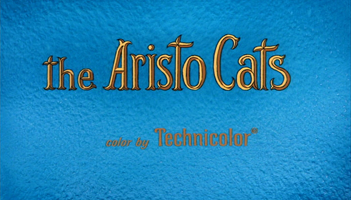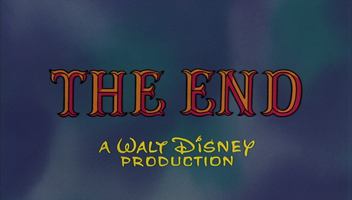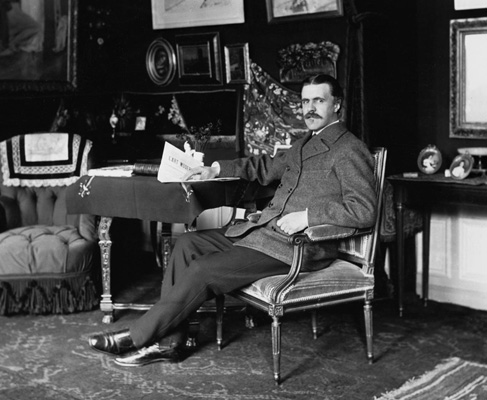
ADAM [deadpan] I have so many thoughts it’s hard to know where to begin. It was weird to see C-3PO cast as a villain.
BROOM His villainy was as minimal as possible.
BETH He was just an annoyance.
BROOM In this replay of the plot of 101 Dalmatians, they had, clearly, intentionally dialed down the threat level. There was essentially no threat here.
BETH Well, death by oven.
BROOM No. He was just holding them in there until he could send them to Timbuktu. That was the greatest threat that was ever held over them.
ADAM It was sort of like 101 Dalmatians and Lady and the Tramp, turned down to five.
BROOM Turned way down. So: based on having seen stills of this movie — or maybe even a few seconds of animation — I expected that what would be depressing about it would be the appearance of it, that it would look ugly and hairy and be shoddy. And that turned out not to be a problem at all. I thought the animation was actually all it had going for it. It felt like this non-starter project had been handed over to the art department and they had done a fine, serviceable job of it. What it was lacking was any reason to be, any story interest. I also thought the musical score really dragged it down constantly. It was the laziest kind of imitation of Henry Mancini, which was the least considered, most reflexive thing to do in 1970. It never played the drama of what was actually happening. Any scene with the geese just had that imitation-Mancini “goose walk music!” The same music: when they were in the water, when they were on the shore, when they were in the city street at night with the drunk goose — in all of those situations, the same thing: [hums dinky goose music]. The whole movie suffered from the same flaw: total insensitivity to whatever little story there was.
BETH Plus — and I don’t remember if this was true of Lady and the Tramptoo — the music didn’t seem to have anything to do with the period. Maybe in Lady and the Tramp the music just worked better because it wasn’t in a style that was as obviously popular to us as this was. I don’t remember the music from Lady and the Tramp so well; just the Italian song.
ADAM Peg had a song. “He’s a Tramp.”
BROOM Yeah, that was actually pretty similar in spirit to the songs from Aristocats.
BETH Right. That wasn’t very 1910 either.
BROOM When you guys started joking about how this wasn’t very 1910-ish, I didn’t even realize that it was supposed to be 1910; I missed that at the beginning. There was nothing 1910 about it in any way. The fact that she had a butler was about it. If they had said that this was 1970 and this just happened to be a fantastically upper-crust lady that would have been just as acceptable.
ADAM It was a little like “Johnnie Fedora and Alice Bluebonnet” in the look.
BROOM I thought it was just an all-purpose cartoon look. And it was full of so many blatant anachronisms, especially in who those alley cats were. A bead-wearing hippie?
ADAM Which was more embarrassing: the alley cats here, or the vulture-Beatles in The Jungle Book?
BROOM I thought this was far more embarrassing. I think the Siamese cat in this movie was the most embarrassing thing yet. “Shanghai Hong Kong egg foo yung?” We thought the Siamese cats in Lady and the Tramp were shameful — they were models of restraint compared to this guy.
ADAM I mean, which was more embarrassingly trying to be “with it,” like someone’s dad talking about punk rock.
BETH Those vultures were pretty embarrassing. This was embarrassing too. They’re both embarrassing. Equally.
BROOM The sneaking-around Henry Mancini music for the butler was deeply embarrassing for me. Every time this stuffy old butler showed up, in come the jazz bass and the trombones, which were just completely wrong. They had everything to do with being up to date, and nothing to do with the movie.
ADAM The movie was just so boring!
BETH It was very boring. Especially if you’re tired, it’s really unwatchable.
ADAM A third of this movie was like, “François! Juliette! Take your musique lesson!”
BROOM Their names were Berlioz and Toulouse!
ADAM I know.
BETH And Marie.
BROOM Who do you think Marie was? Marie Curie?
ADAM It was just painfully dull. “What are all the things we can think of about upper-crust French people? Doing boring shit?” I’m surprised they didn’t have a whole scene that was a porcelain-painting lesson.
BROOM That the second song was basically just “Play your scales! Play your scales!” just typified the whole movie. And that scene: I understand that the animator probably went to the music director and said “We just can’t afford to worry about him playing the right notes on the piano, so live with it,” but it was really distractingly absurd, what he was doing.
ADAM It was weird to picture Eva Gabor making love to Baloo.
BROOM The love in this movie was too sexual. She was too trampy.
ADAM Yeah. O’Malley cat comes up to her and she immediately starts licking herself. In front of her children!
BROOM The implication was that they were eagerly thinking, “I hope that alley cat does Mom.” They never established the idea that this family unit is lacking a father. I mean, it is, obviously, by the arithmetic of it, but there was no emotional sense of any need. So when they’re peeking out at mom vamping for this sleazeball, all you can imagine is that he’s going to have his way with her, which is clearly all he wants. He never cared about them. “Hey, babe!” But the main problem with it was, as I said, that it was just an animated movie about cats for the sake of there being an animated movie about cats.
BETH It had a Scooby-Doo quality to it. Something about the animation reminded me of Scooby-Doo.
ADAM It was classier than that. But it seemed like it was really labored. When they did Madame’s face, it was the most elaborate thing in the movie, but it was so cross-hatched with effort. Like they’d forgotten how to do faces. Or how to erase pencil marks. It just felt constipated with effort.
BROOM I felt like I was watching the animators’ workshop working without direction. The director had checked out, or management was somehow confused, and so they were all going to work and doing their animator-y things. Like the first ten minutes, which pointlessly consisted of watching the doddering lawyer go up the stairs: his choreography was very elaborate, and you got to see him do all kinds of stuff. It looked like exactly the technical stuff that occupies animators. Like: there’s going to be spring-back in his body, and then his foot will counter-balance by going back, and then he’s going to bend and stretch him this way, and then there will be two kinds of motion at once… it looks like every animator was doing his pet project or exercise, because there was no coordination to make those moments meaningful as anything other than animated business. And I think that what reminds you of Scooby-Doo is the fact that all the post-production was so slapdash and insensitive.
BETH It’s the sound effects. It’s that late-60s sound-effect thing.
BROOM Not trying to create any particular dramatic arc or impression; just getting stuff out of a bucket and dropping the stuff on the movie until it’s done.
ADAM Did we just hear this tune: [hums “Baby Elephant Walk”]?
BROOM No! That’s real Henry Mancini, that’s “Baby Elephant Walk.” When I hummed before, that’s what started you thinking of it, but I was just doing my impression of the goose music from this movie.
ADAM What was your favorite moment in the movie? Because I had one favorite moment.
BROOM My favorite moment was when the horse came into the house to sing at the end.
ADAM My favorite moment was when Madame wakes up in the middle of the night and she has long hair. It reminded me of “A Rose for Emily.” Do you know that story?
BROOM Is that the Faulkner story where the old lady sleeps in the same bed with her dead husband?
ADAM Yes.
BROOM What was your least favorite moment?
ADAM The other parts! It was really boring. The drama of O’Malley almost drowning in the river? Not dramatic! Not interesting! And the train? There were all these things that felt like, “[exhausted groan], so what other obstacles can we throw at them?”
BETH Exactly. When Marie fell off into the water, that just felt like crappy scriptwriting.
ADAM None of it hung together at all.
BROOM Yeah, you never believed in any of those moments.
ADAM “We need to fit ten obstacles between the porcelain painting scenes. Okay, dogs. Okay, I guess dogs are southern. Okay, and there will be a madcap scene with a sidecar. And a windmill. All right, fine. Uh… okay, um…. train trestles…”
BROOM “I know, a retrieving-something-from-a-sleeper’s-grip scene. Okay, good. Do you want to do feather-tickle or fishing rod? Let’s do fishing rod. Well, let’s get a tickle in there too. Okay.” Ugh, and the action music for the windmill chase scene was so awful. They had worked out all these intricate gags, and the music was just like the same blaring brass hits, repeated over and over to cover the whole sequence. Beth, what do you think you would think of this movie as a six-year-old.
BETH Bored. Very bored. But I would like the part at the end when the lights are flashing and everything was changing into different colors.
ADAM I would have been entranced by the fact that it was set in Paris. I would have found that so romantic.
BETH I would have liked that too. And I did like the backgrounds. The elaborate furniture and that sort of stuff, I thought, was nicely done. It had a mood.
BROOM I think I would have found it congenial and pleasant to look at. It would have been boring, of course, because it is boring, it just doesn’t grip you. But I thought that in terms of being spaces to imagine yourself in, it would have served. It was a series of inoffensively pleasant places, like your family took you out to a restaurant that was perfectly fine.
BETH It had some nice space. Like when they visit the alley cats, that house is a cool space.
BROOM I thought that the backgrounds were actually better than the Jungle Book backgrounds, the previous movie’s. But they didn’t hold a candle to 101 Dalmatians.
ADAM Okay: this was essentially the same movie as 101 Dalmatians, so why was this so much worse? Was it because the characters weren’t properly developed? There was a slackness to this that there wasn’t in 101 Dalmatians.
BROOM Yes. I think there was a witlessness to both the scripting and the directing. And, as I’ve said, post-production elements like the sound effects and music.
BETH I think it was mostly the script. I think the lack of threat was a problem. There wasn’t enough conflict driving the action, throughout. Once they were just trying to make their way home, that’s all that was happening.
BROOM This was not a sharp enough movie to afford the inclusion of geese with “bad senses of humor.” The idea that they were making lame jokes — we weren’t flying nearly high enough for them to pull that off. Is that a British stereotype? That they have wretched senses of humor?
BETH Yes, I think the idea that the British like “silly jokes” is a stereotype.
ADAM Why did they take the time to go see the alley cats when they could have just gone home?
BETH They were entranced. The kids were tired and she was in love.
ADAM They obviously didn’t miss Madame that much.
BROOM They were waiting to show up in the daytime.
BETH Okay, let’s read the New York Times review.
[BROOM begins looking it up]
BROOM Oops, I spelled “Aristocrats” correctly by mistake. Which reminds me, I wanted to make a joke, like, about the part of the movie where…
ADAM Where they were, like, all fucking each other?
BROOM Yeah. Where the mom makes a hairball right into the daughter’s mouth.
[we read the review]
BROOM That review just makes you realize that 1970 must have been a terrible time.
ADAM It’s true. All the great institutions had lost all confidence in themselves, The New York Times no less than Walt Disney Studios.
BROOM It had its commas in the wrong places, and it was all about “Know what I’m saying, my swinging readers?” That was my most embarrassing moment: the review. Too bad there wasn’t a byline; if that had been baby Janet Maslin or something, that would have been sobering to us. But it was probably someone who didn’t last. Probably got high a little too often. Plus they got this movie so wrong.
ADAM It must have been such a culturally dislocated time.
BROOM Somewhere in between The Jungle Book, which just had that tentative Beatles thing, and now, you can sense that there was just an anti-cultural explosion. And it’s not even like Disney was trying to embrace that, here.
BETH No. They were just doing something mainstream.
BROOM Which had gotten so dumbed down. If had been Marshall McLuhan writing about culture then, of course I would have said that everything had gotten dumber. It’s gotten so much dumber over the course of these movies, right?
BETH Well, yeah.
BROOM Since when? Has it been downhill since World War II?
BETH No. Alice in Wonderland isn’t dumb.
ADAM As these things go. And neither is Dalmatians.
BROOM But Cinderella was dumb, and that was the start of the post-war period. Dalmatians wasn’t dumb, I suppose, but it definitely had its sights lower.
ADAM I suppose that’s right. We just liked it because there were the funny bachelor parts at the beginning, but the actual puppies part was pretty rote.
BROOM And surely that’s why it was popular. Kids wanted to watch puppies.
ADAM Right, not the swinging bachelor dog.
BROOM So, not to give away the story, but looking forward we’re going to have about twenty years of riding the rapids of dumbed-down mainstream stuff, and then there’s finally going to be the revolution, the renaissance, but it’s going to be this liberal-agenda Pocahontas shit, and it’s sort of sad to think that that was the middlebrow’s best hope for renewal. Is that really what the storyline is?
ADAM The best hope for renewal is Rapunzel. I have a lot riding on Rapunzel.
BROOM That’s two from now, right? The Princess and the Frog comes first?
ADAM Yeah.
BROOM I don’t know what you can have riding on that. You know, Ross Douthat, before his New York Times appearances —
ADAM His disappointing New York Times appearances.
BROOM — wrote something on The Atlantic’s site about how he misses middlebrow movies — how it used to be the glory of Hollywood that it made something genuinely, wholesomely middlebrow. And I feel like that’s what we’ve been watching, here. Snow White was just an experiment, they didn’t know what it was, but then after the war, they found what it was: it was middlebrow, it was something for everyone to come and see. And now we’re just watching its standards slide. And that’s sad. And it is because of those damn hippies; that’s how that review made me feel.
ADAM It’s like the French revolution: it’s not the revolutionaries’ fault that everything went to pot, even though everything did. I mean, the things that happened in the 60s and 70s were by and large good for everyone, but they were wrenching.
BROOM I’m not proposing that those things shouldn’t have happened, or that it would be better if they hadn’t. But there’s a cause and effect relationship.
ADAM Well, this isn’t the place for macro-cultural criticism.



